YAMAHA KODIAK 700 2020 Owners Manual
Manufacturer: YAMAHA, Model Year: 2020, Model line: KODIAK 700, Model: YAMAHA KODIAK 700 2020Pages: 178, PDF Size: 6.7 MB
Page 141 of 178
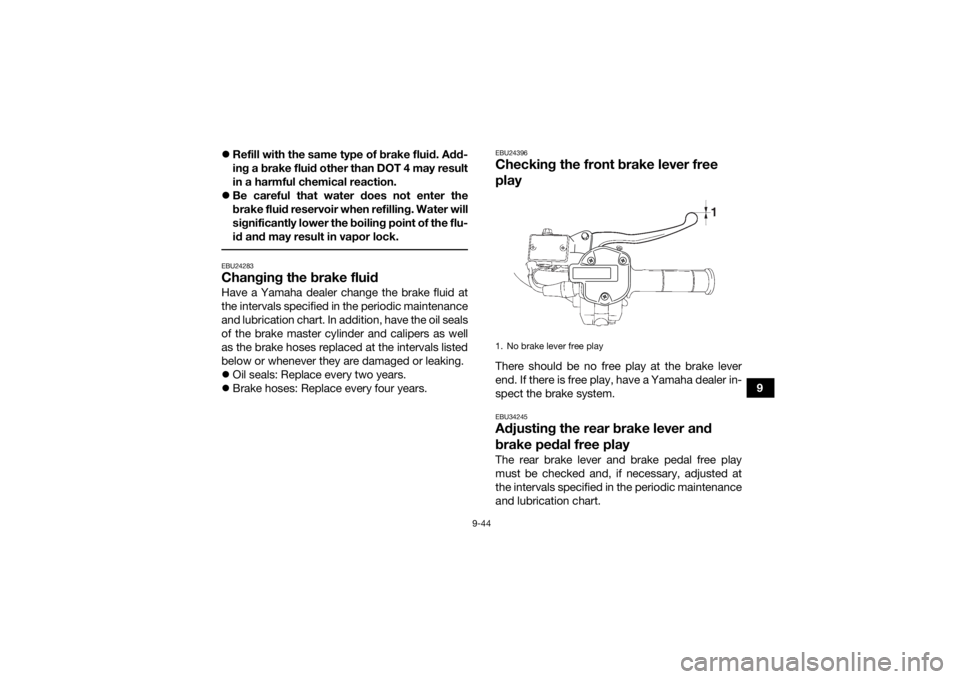
9-44
9
Refill with the same type of brake fluid. Add-
ing a brake fluid other than DOT 4 may result
in a harmful chemical reaction.
Be careful that water does not enter the
brake fluid reservoir when refilling. Water will
significantly lower the boiling point of the flu-
id and may result in vapor lock.
EBU24283Changing the brake fluidHave a Yamaha dealer change the brake fluid at
the intervals specified in the periodic maintenance
and lubrication chart. In addition, have the oil seals
of the brake master cylinder and calipers as well
as the brake hoses replaced at the intervals listed
below or whenever they are damaged or leaking.
Oil seals: Replace every two years.
Brake hoses: Replace every four years.
EBU24396Checking the front brake lever free
playThere should be no free play at the brake lever
end. If there is free play, have a Yamaha dealer in-
spect the brake system.EBU34245Adjusting the rear brake lever and
brake pedal free playThe rear brake lever and brake pedal free play
must be checked and, if necessary, adjusted at
the intervals specified in the periodic maintenance
and lubrication chart.1. No brake lever free play
UB5K62E0.book Page 44 Thursday, May 9, 2019 2:59 PM
Page 142 of 178
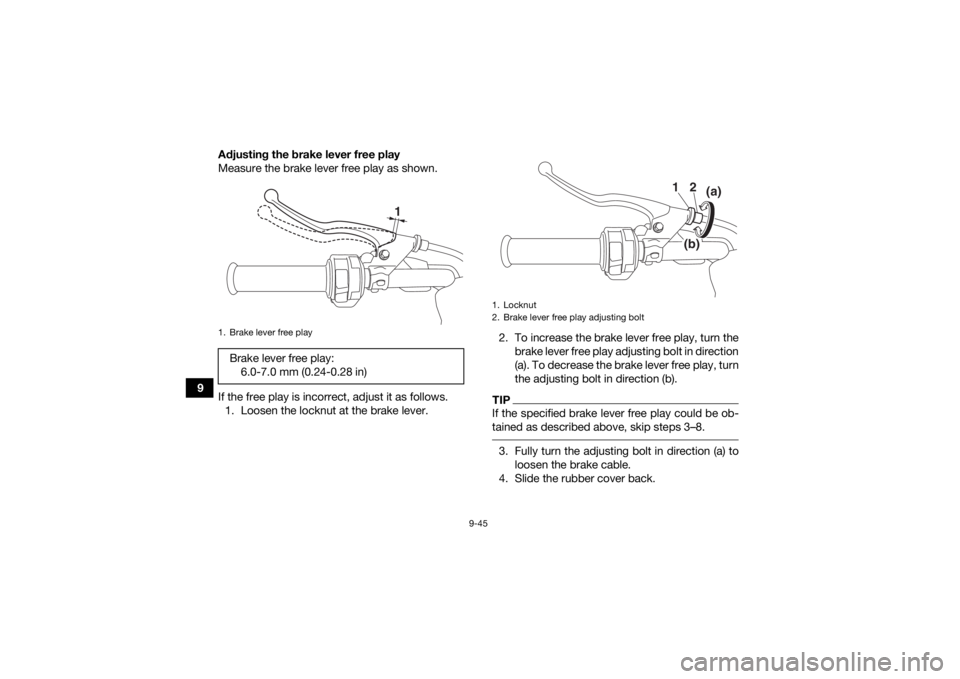
9-45
9Adjusting the brake lever free play
Measure the brake lever free play as shown.
If the free play is incorrect, adjust it as follows.
1. Loosen the locknut at the brake lever. 2. To increase the brake lever free play, turn the
brake lever free play adjusting bolt in direction
(a). To decrease the brake lever free play, turn
the adjusting bolt in direction (b).
TIPIf the specified brake lever free play could be ob-
tained as described above, skip steps 3–8. 3. Fully turn the adjusting bolt in direction (a) toloosen the brake cable.
4. Slide the rubber cover back.
1. Brake lever free playBrake lever free play: 6.0-7.0 mm (0.24-0.28 in)
1
1. Locknut
2. Brake lever free play adjusting bolt
(a)
(b)
12
UB5K62E0.book Page 45 Thursday, May 9, 2019 2:59 PM
Page 143 of 178

9-46
9
5. Loosen the brake cable adjuster locknut.
6. To increase the brake lever free play, turn the
brake lever free play adjusting nut in direction
(a). To decrease the brake lever free play, turn
the adjusting nut in direction (b).
7. Tighten the brake cable adjuster locknut.
8. Slide the rubber cover to its original position.
9. Tighten the locknut at the brake lever.
Adjusting the brake pedal free play
Measure the brake pedal free play as shown. If the free play is incorrect, adjust it as follows.
1. Remove panel G.
2. Loosen the locknut.
1. Brake cable adjuster locknut
2. Brake lever free play adjusting nut
3. Rubber cover
2
3
1
(a)(b)
1. Brake pedal free playBrake pedal free play: 12.0–17.0 mm (0.47–0.67 in)
1
UB5K62E0.book Page 46 Thursday, May 9, 2019 2:59 PM
Page 144 of 178
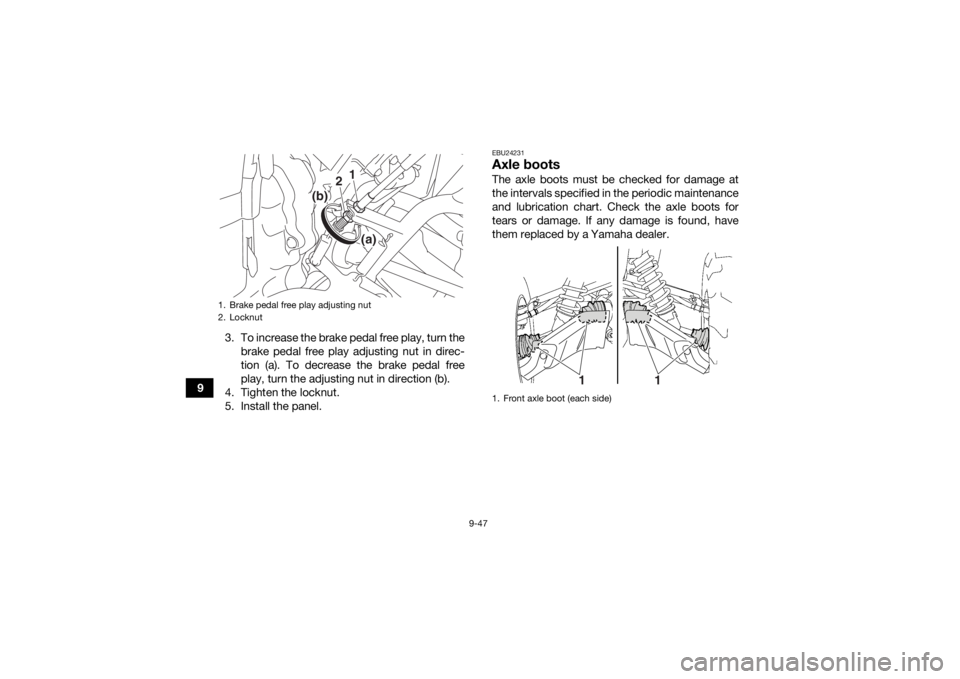
9-47
93. To increase the brake pedal free play, turn the
brake pedal free play adjusting nut in direc-
tion (a). To decrease the brake pedal free
play, turn the adjusting nut in direction (b).
4. Tighten the locknut.
5. Install the panel.
EBU24231Axle bootsThe axle boots must be checked for damage at
the intervals specified in the periodic maintenance
and lubrication chart. Check the axle boots for
tears or damage. If any damage is found, have
them replaced by a Yamaha dealer.
1. Brake pedal free play adjusting nut
2. Locknut
2
(a)
(b)
1
1. Front axle boot (each side)
1
1
UB5K62E0.book Page 47 Thursday, May 9, 2019 2:59 PM
Page 145 of 178
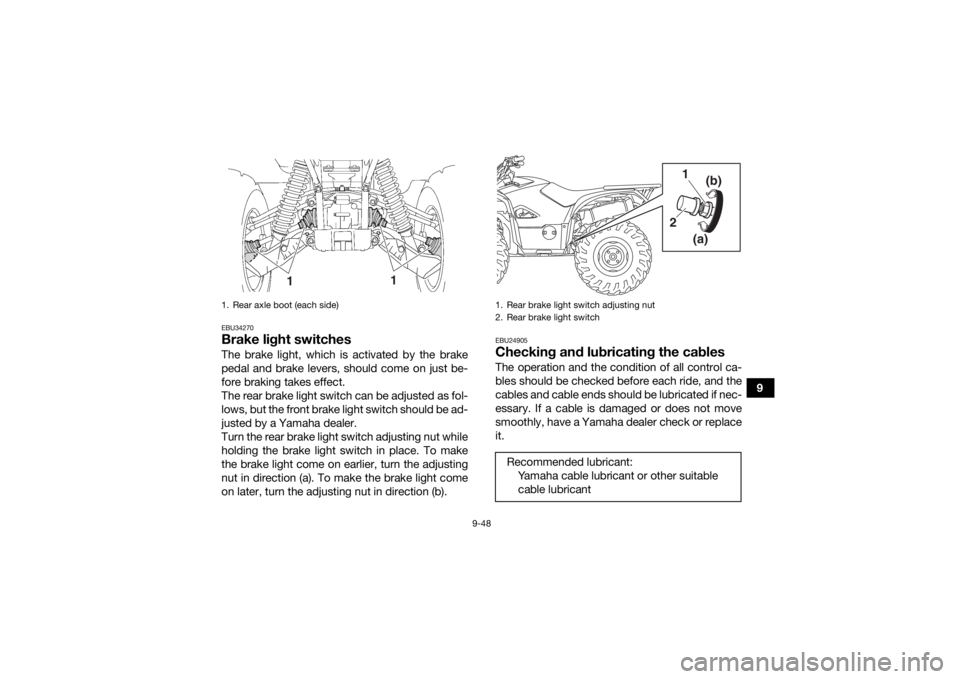
9-48
9
EBU34270Brake light switchesThe brake light, which is activated by the brake
pedal and brake levers, should come on just be-
fore braking takes effect.
The rear brake light switch can be adjusted as fol-
lows, but the front brake light switch should be ad-
justed by a Yamaha dealer.
Turn the rear brake light switch adjusting nut while
holding the brake light switch in place. To make
the brake light come on earlier, turn the adjusting
nut in direction (a). To make the brake light come
on later, turn the adjusting nut in direction (b).
EBU24905Checking and lubricating the cablesThe operation and the condition of all control ca-
bles should be checked before each ride, and the
cables and cable ends should be lubricated if nec-
essary. If a cable is damaged or does not move
smoothly, have a Yamaha dealer check or replace
it.
1. Rear axle boot (each side)
1
1
1. Rear brake light switch adjusting nut
2. Rear brake light switchRecommended lubricant:
Yamaha cable lubricant or other suitable cable lubricant
1
2 (b)
(a)
UB5K62E0.book Page 48 Thursday, May 9, 2019 2:59 PM
Page 146 of 178
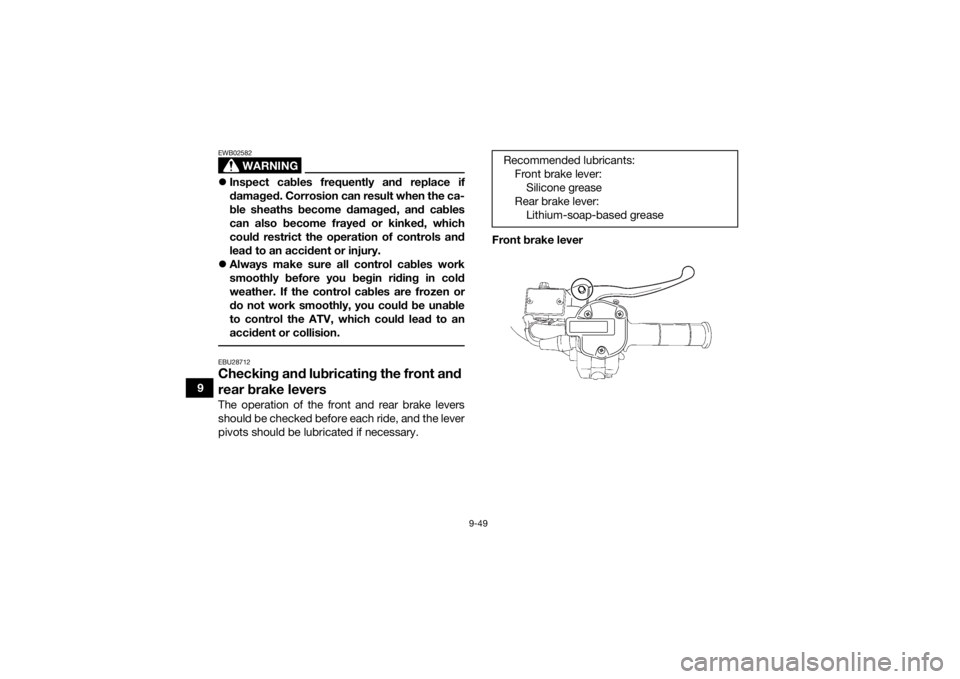
9-49
9
WARNING
EWB02582Inspect cables frequently and replace if
damaged. Corrosion can result when the ca-
ble sheaths become damaged, and cables
can also become frayed or kinked, which
could restrict the operation of controls and
lead to an accident or injury.
Always make sure all control cables work
smoothly before you begin riding in cold
weather. If the control cables are frozen or
do not work smoothly, you could be unable
to control the ATV, which could lead to an
accident or collision. EBU28712Checking and lubricating the front and
rear brake leversThe operation of the front and rear brake levers
should be checked before each ride, and the lever
pivots should be lubricated if necessary. Front brake lever
Recommended lubricants:
Front brake lever:Silicone grease
Rear brake lever: Lithium-soap-based greaseUB5K62E0.book Page 49 Thursday, May 9, 2019 2:59 PM
Page 147 of 178
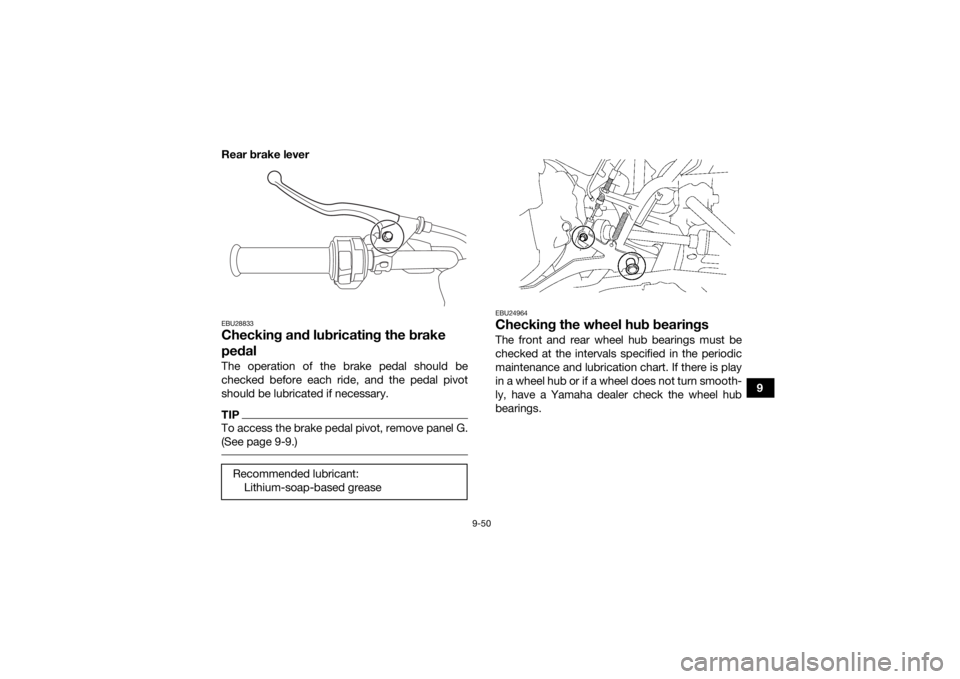
9-50
9
Rear brake lever
EBU28833Checking and lubricating the brake
pedalThe operation of the brake pedal should be
checked before each ride, and the pedal pivot
should be lubricated if necessary.TIPTo access the brake pedal pivot, remove panel G.
(See page 9-9.)
EBU24964Checking the wheel hub bearingsThe front and rear wheel hub bearings must be
checked at the intervals specified in the periodic
maintenance and lubrication chart. If there is play
in a wheel hub or if a wheel does not turn smooth-
ly, have a Yamaha dealer check the wheel hub
bearings.
Recommended lubricant: Lithium-soap-based grease
UB5K62E0.book Page 50 Thursday, May 9, 2019 2:59 PM
Page 148 of 178
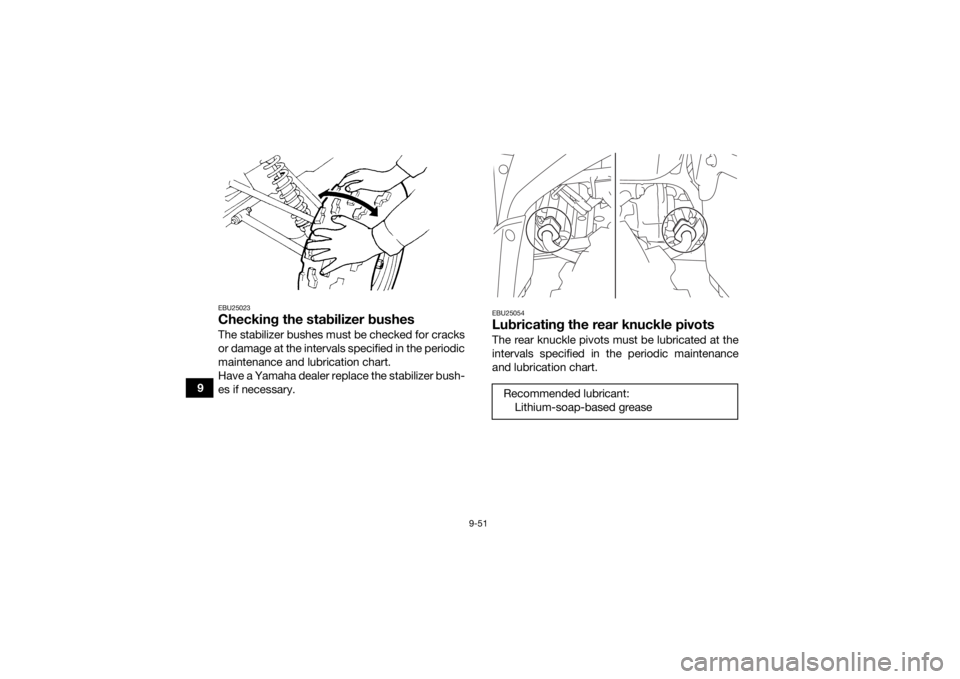
9-51
9
EBU25023Checking the stabilizer bushesThe stabilizer bushes must be checked for cracks
or damage at the intervals specified in the periodic
maintenance and lubrication chart.
Have a Yamaha dealer replace the stabilizer bush-
es if necessary.
EBU25054Lubricating the rear knuckle pivotsThe rear knuckle pivots must be lubricated at the
intervals specified in the periodic maintenance
and lubrication chart.Recommended lubricant:Lithium-soap-based grease
UB5K62E0.book Page 51 Thursday, May 9, 2019 2:59 PM
Page 149 of 178
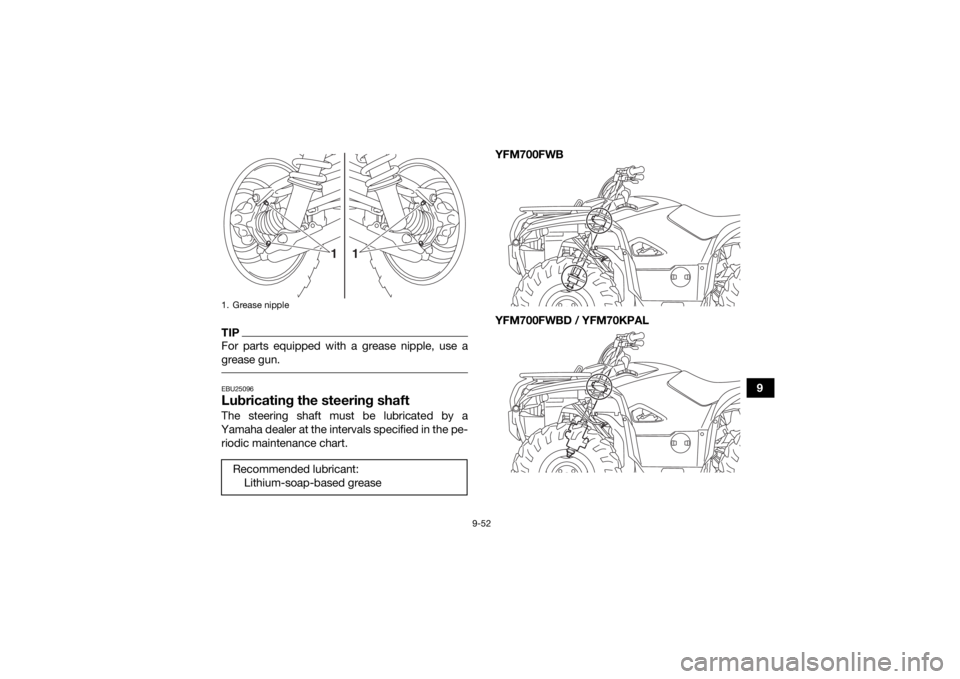
9-52
9
TIPFor parts equipped with a grease nipple, use a
grease gun. EBU25096Lubricating the steering shaftThe steering shaft must be lubricated by a
Yamaha dealer at the intervals specified in the pe- riodic maintenance chart. YFM700FWB
YFM700FWBD / YFM70KPAL1. Grease nippleRecommended lubricant:
Lithium-soap-based grease
1
1
UB5K62E0.book Page 52 Thursday, May 9, 2019 2:59 PM
Page 150 of 178
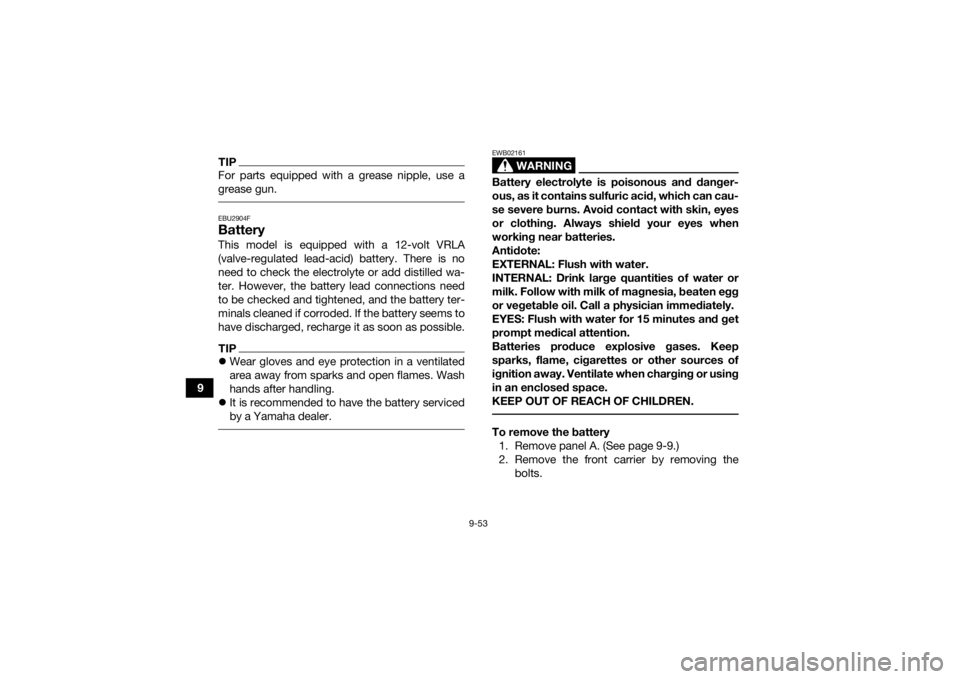
9-53
9
TIPFor parts equipped with a grease nipple, use a
grease gun. EBU2904FBatteryThis model is equipped with a 12-volt VRLA
(valve-regulated lead-acid) battery. There is no
need to check the electrolyte or add distilled wa-
ter. However, the battery lead connections need
to be checked and tightened, and the battery ter-
minals cleaned if corroded. If the battery seems to
have discharged, recharge it as soon as possible.TIPWear gloves and eye protection in a ventilated
area away from sparks and open flames. Wash
hands after handling.
It is recommended to have the battery serviced
by a Yamaha dealer.
WARNING
EWB02161Battery electrolyte is poisonous and danger-
ous, as it contains sulfuric acid, which can cau-
se severe burns. Avoid contact with skin, eyes
or clothing. Always shield your eyes when
working near batteries.
Antidote:
EXTERNAL: Flush with water.
INTERNAL: Drink large quantities of water or
milk. Follow with milk of magnesia, beaten egg
or vegetable oil. Call a physician immediately.
EYES: Flush with water for 15 minutes and get
prompt medical attention.
Batteries produce explosive gases. Keep
sparks, flame, cigarettes or other sources of
ignition away. Ventilate when charging or using
in an enclosed space.
KEEP OUT OF REACH OF CHILDREN. To remove the battery
1. Remove panel A. (See page 9-9.)
2. Remove the front carrier by removing the bolts.
UB5K62E0.book Page 53 Thursday, May 9, 2019 2:59 PM